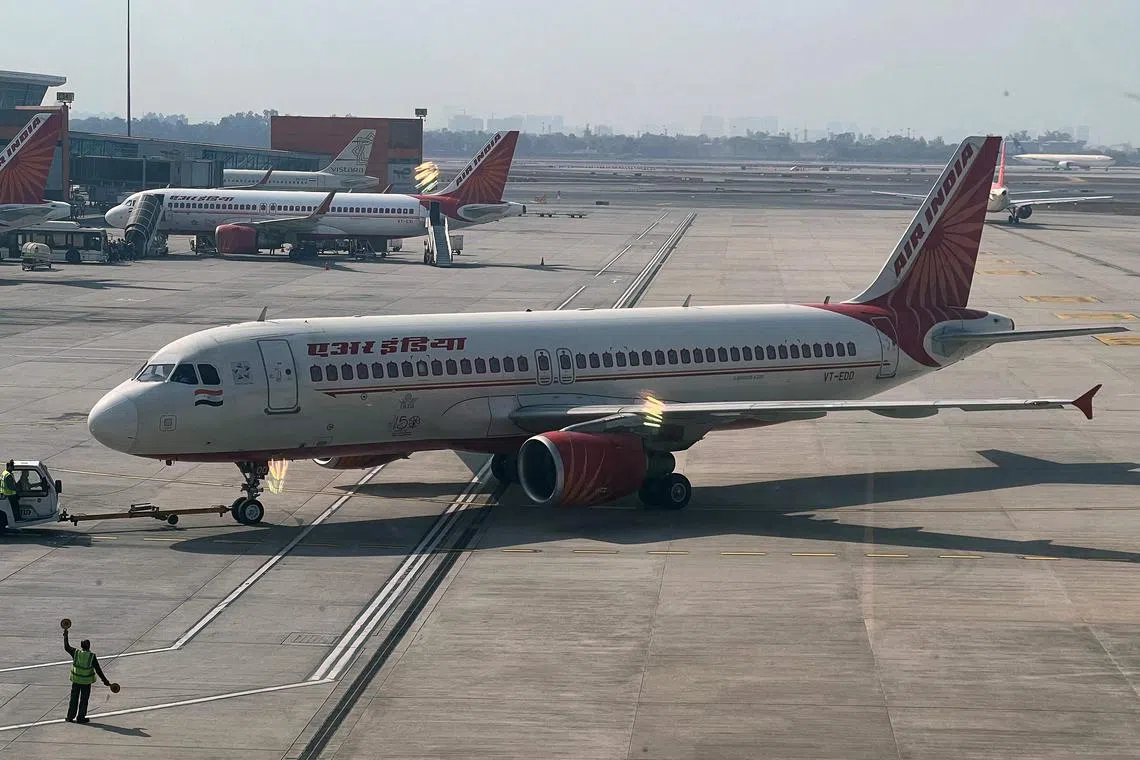India to splurge $16b to improve air travel, boost airport numbers from 148 to 220
Sign up now: Get ST's newsletters delivered to your inbox

Air India last month announcing the biggest deal in commercial aviation history.
PHOTO: AFP
Follow topic:
NEW DELHI - India will spend about 980 billion rupees (S$16 billion) over the next two years on airports, with airline orders for hundreds of new planes – to meet resurgent travel demand – putting pressure on existing infrastructure.
The world’s fastest-growing aviation market aims to boost the number of airports to 220 by 2025 from the current 148, for which private builders will invest about US$9 billion (S$12 billion), and the state-run Airports Authority of India will bring the rest. It involves greenfield projects, new terminals and the renovation of existing facilities, including former military airfields left over from colonial times.
Though the country of 1.42 billion people has a fleet of only some 700 aircraft – United Airlines flies more – existing airports in major cities such as Delhi and Mumbai are running out of parking and landing slots.
The move comes as India asserts itself more broadly on the global stage, buoyed by a rising consumer base and growth in the US$3.2 trillion economy that is on track to exceed China’s.
The country has already been making its mark in aviation, with Air India in February announcing the biggest deal in commercial aviation history.
India wants to be a powerhouse in air transport, according to Civil Aviation Minister Jyotiraditya Scindia, who kicks off the three-day CAPA India Aviation Summit on Monday. Boeing forecasts India’s passenger traffic will grow at a rate of nearly 7 per cent annually, compared with 4.9 per cent in China from 2022 through 2041.
“The growth in aviation infrastructure will bring a huge amount of economic upside, and new airports will improve the quality of life for most people partly because of bad road infrastructure and slow trains in India,” said Mr Jayant Mukhopadhaya, researcher at the International Council of Clean Transportation.
Prime Minister Narendra Modi wants to make the country a world-class connecting hub as well as a destination for tourists and businesses. Linking smaller cities by air is part of his development agenda.
Air India, owned by the nation’s largest conglomerate Tata Group, has ordered 470 aircraft, while IndiGo, the nation’s No. 1 airline, is expected to place a larger order. Others are beefing up their fleets as well.
With the new acquisitions, India is trying to catch up with bigger aviation markets such as China. Data from Cirium shows that Asia’s third-largest economy has more than 1,400 aircraft on order, including letters of intent that are less firm than outright purchase.
That is almost twice as many as China, which, meanwhile, seeks to almost double its airports to 450 by 2035. China currently operates a significantly larger fleet than India.
Major airport developments in India include Adani Group’s 1,160ha airport in Navi Mumbai that will handle 90 million passengers by 2036.
Capital New Delhi will also see a new facility with a final capacity of 70 million travellers, and it is being developed by Zurich Airport International. Other greenfield airports will come up in the states of Karnataka, Gujarat and Andhra Pradesh.
Pollution costs
Some experts say such large-scale infrastructure projects could add to the air pollution, which according to a report by Dalberg Advisors, costs the country US$95 billion in gross domestic product annually. That underscores the tension between Mr Modi’s aim to make India a developed nation in the next 25 years and his goal of reaching net zero by 2070.
“Few nations have such ambitious goals for the aviation sector as India, and achieving those goals will come with an increase in emissions,” said Mr Lewis Burroughs, aviation manager at Virgina-based ICF International. “Until major technological changes occur, the two will be heavily linked.”
India wants to have more than 90 carbon-neutral airports by 2024, a difficult challenge considering only two such airports exist now, in New Delhi and the southern port city of Kochi.
The ongoing projects near Mumbai and Delhi have already faced backlash over environmental concerns. Sites should be selected in a way that minimises the environmental and ecological impacts, said Conservation Action Trust founder Debi Goenka.
Representatives for the two facilities under construction said their plan is to cut emissions by using renewable sources of power and electric vehicles.
Growth focus
But given Mr Modi’s focus on growth – he is targeting a gross domestic product of US$5 trillion by 2025 – aviation will continue to be high on his priority list. The London-based Centre for Economics and Business Research predicts India to become a US$10 trillion economy by 2035.
Local air traffic surged 96 per cent in January, matching the 2019 pre-pandemic level, according to the Directorate General of Civil Aviation.
Besides the domestic rebound, India is also emerging as one of the preferred locations for manufacturers looking to shift away from China as tensions between Washington and Beijing grow.
More businesses such as Apple partner Foxconn Technology Group are setting up factories, creating hundreds of thousands of jobs in India. That means the nation needs better airports with enhanced capacity as travel demand surges.
“India is a large country, and we definitely need more airports to divert traffic directly to different locations rather than funnelling them to our already over-burdened airports,” said Mr Goenka. BLOOMBERG

